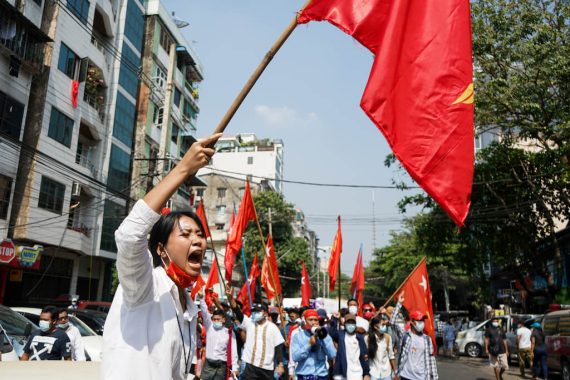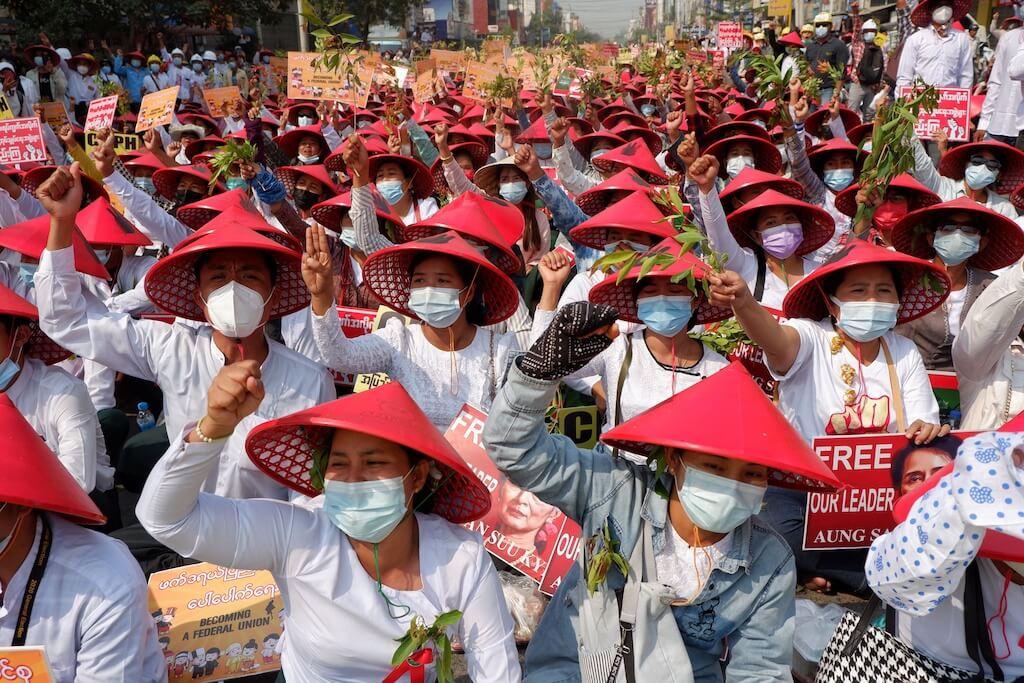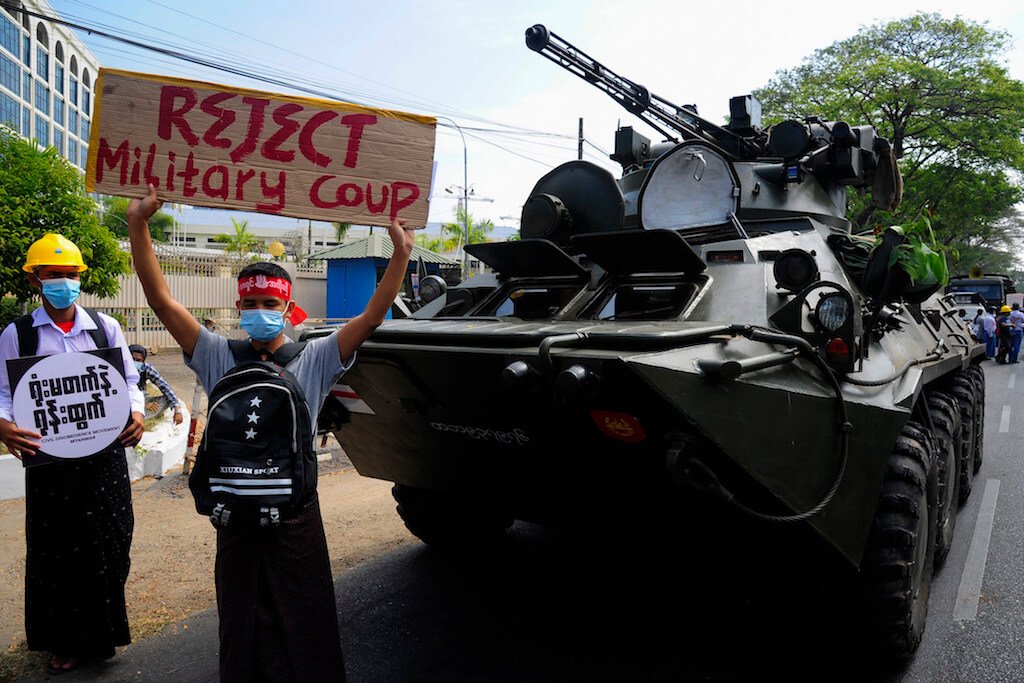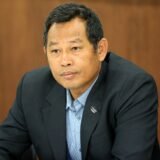National armed forces typically do not use snipers, heavily armed infantry divisions, and fighter-bombers to quell all unarmed peaceful protests – and during peace time. But Myanmar’s Tatmadaw, or the defense services, do.
Consequently, as evidenced in the thousands of social media comments, the overwhelming majority of public opinion in Myanmar has irreversibly turned against the armed forces. The multiethnic public views the Tatmadaw as a ruthless occupying force at best – and a downright terrorist mafia at worst.
For the country’s non-Burmese ethnic nationalities or national minorities such as the Karen, Kachin, Shan, Chin, Mon, Rakhine, Rohingya, and so on, the Tatmadaw – primarily commanded by majoritarian Burmese and exclusively by Buddhists – has been an alien colonial occupier.
If these communities in distress self-organize armed resistance, the Tatmadaw typically resorts to a variation of the old British era “pacification” military campaigns. It has burned entire ethnic minority villages, forcibly relocated villagers into controllable areas, or simply violently deported them across the borders into neighboring Thailand, India, or China.
To date, Myanmar under the military’s dominance is home to possibly the longest low-intensity civil war in the world, which ensued after World War II ended. There are about two dozen ethnic armed organizations, with varying troops all across the border regions, which are the ancestral homelands of myriad of ethnic minorities. The Tatmadaw’s war crimes and crimes against humanity are well-documented, and include rape as a weapon of communal subjugation, forced labor, summary execution, torture, murder, and so on.
In Myanmar’s western region of Rakhine that is adjacent to Bangladesh, the army has been engaged in systematic and sustained campaigns of terror against the Rohingya ethnic minority for the last 40 years. One of the major reasons the United Nations General Assembly established the mandate of the UN Special Rapporteur on the situation of human rights in Myanmar as early as 1993 was the credible news reports of crimes against humanity against this Muslim minority.
In 2016 and 2017, the Burmese army waged the largest genocidal attacks on this unarmed, destitute, and vulnerable Muslim population of roughly two million. The attacks made the international community stand up and pay attention to the situation.
According to the report of the UN International Independent Fact-Finding Mission on Myanmar, in the span of 10 months, the army destroyed about 39,000 homes, mosques, schools, rice warehouses, and businesses while killing an estimated 10,000 Rohingyas of all ages and mass-raping women. The two campaigns of genocidal terror triggered the survival flight of a total of 840,000 survivors into neighboring Bangladesh.

VIDEO: Myanmar activist speaks out while on the run from police
This large-scale systematic destruction of Rohingyas as a minority community and the crimes of deportation en masse have resulted in two major judicial and investigative processes. The International Court of Justice (ICJ) in The Hague has a pending genocide case after Gambia launched a legal challenge against Myanmar, as a state party to the Convention on the Prevention and Punishment of the Crime of Genocide, on violating its treaty obligations to prevent genocide and punish perpetrators under the terms of the Genocide Convention.
Meanwhile, in the same city, the International Criminal Court (ICC) has launched a full investigation into Myanmar’s crimes of deportation and other grave international crimes that have led to the exodus of nearly one million Rohingyas from their ancestral land of Western Myanmar into Bangladesh. In both court cases, Myanmar’s Tatmadaw is the main instrument of the international crimes and the Burmese commanders are the principal architects behind the crimes.
Although possibly not widely and severely despised among the majoritarian Burmese society, in segments of the population the army (Tatmadaw) is deeply despised for its bloody crackdown of chronic political unrests, particularly by politically conscious university students, socially engaged Buddhist monks, labor rights activists, and farmers for their vocal criticism and opposition to half a century of military control and dominance over society, political affairs, and the national economy.
The Burmese army has built expansive prison complexes and interrogation or torture centers all across the country where human rights activists, journalists, pro-democracy dissidents, and all types of regime critics are forced to confess to crimes they did not commit.
The Burmese military leaders have long discarded the pledge of the founder of the Myanmar Armed Forces Aung San to build a democratic federated union of multiethnic nations.
Since the commercial opening which followed the collapse of the one-party military dictatorship of General Ne Win with its economically ruinous socialist economy, the military in Myanmar has become the most dominant economic player. The generals, their families, and cronies have raked in their ill-gotten gains to the tunes of billions of dollars while the public at large remained pauperized. Roughly five million working-age Burmese of all backgrounds have left the country as migrant workers for greener pastures across Southeast Asia’s middle-income countries such as Thailand, Malaysia, and Singapore.
Politically, the Burmese military leaders have long discarded the pledge of the founder of the Myanmar Armed Forces Aung San to build a democratic federated union of multiethnic nations who join voluntarily along the principle of ethnic group equality and the right to self-determination. Successive generations of military leaders since the first coup of 1958 have typically been scornful of liberal democratic principles. They view the federal, power-sharing arrangement as a formula for Balkanization.
Against the founding principles extensively worked out and articulated well by Aung San, who is widely viewed as the primary architect of the country’s independence from Britain, the top military commanders, who have had a disproportionate share of power and influence over this nationalist institution, have built a radically different version of the armed forces.
The new incarnation of the Tatmadaw sees itself as the only cohesive national organization capable of keeping the fractious multiethnic country together. The military officer corps sees itself as ideologically “pure”- as a nationalist and selfless body of competent men vis-à-vis bickering, incompetent politicians and unruly activists.
Half a century of total control over society, politics, and the economy is long enough for this ruling and/or dominant institution to forge itself as a distinct social class, with its class, economic, and political interests. Typically, in military-controlled polities, the military is referred to as a state within the state. In the Burmese case, the military has become a separate society within the society at large.
Recommended
Historically, the Tatmadaw was founded as a local proxy against the British in Burma in December 1942 under the patronage of fascist Japan with the nationalist Aung San, Aung San Suu Kyi’s martyred father, as its first commander-in-chief.
Aung San’s vision of this force was that it would be a crucial instrument in the wider popular struggle for liberation to end a century of British colonial rule and, post-independence, to turn it into a professional military, in a federated democratic union of multiethnic peoples.
Suu Kyi herself has repeatedly identified herself with the armed forces – even while the troops have been engaged in vicious military operations – expressing her “genuine affection” for the generals whom she called “my siblings because they are my father’s sons.” She has defended the Tatmadaw against genocide allegations at numerous international fora – most shockingly at the International Court of Justice (ICJ). She has publicly praised this institution as it launched brutal military operations against other minorities such as Buddhist Rakhine on the western coast.
Since she was first elected MP in the 2012 by-elections, Suu Kyi has sought to help open the doors for the hermit-like army leaders, particularly with respect to the militaries in western democracies. Apparently, she was motivated by her desire to trigger some kind of re-professionalization of the Tatmadaw so that it will be a cooperative partner in her main project of democratic reforms. But her reforms were becoming a serious threat “the military elite’s institutional and personal interests – in terms of political influence, bureaucratic dominance, and financial interests.
The top commanders of the Burmese army have come to fear the prospect of having to face justice as a result of the ICC’s full investigation into the military’s atrocities against Rohingyas. To make matters worse, the well-known personal animosities between the Commander-in-Chief Min Aung Hlaing, who was originally scheduled to retire this July, and Suu Kyi finally boiled over. Accordingly, the coup of February 1 was the military establishment’s attempt to re-assert its control in the most radical and direct ways.
However, the coup leaders in Myanmar were stung by the incredibly decisive popular opposition from society at large. Nor did they foresee that the ethnic armed organizations, which had signed nationwide ceasefire agreements with the generals, would throw in their lots with the millions of defiant protesters who have resorted to civil disobedience.
Perhaps the action that has had the most chilling and crippling impact on the coup leaders is the fact that the Civil Disobedience Movement enjoys tremendous support and participation by the hundreds of thousands of civil servants who serve in all non-security ministries including the important Foreign Ministry and other technical ministries such as Health, Transport, Construction, Mining, Forestry, Agriculture, Finance, Education, and so on.
On February 26, Myanmar’s Permanent Representative to the UN Kyaw Moe Tun made world news headlines when he officially briefed the UN General Assembly on the people’s revolt – which he openly endorsed – and urged the UN not to recognize the coup regime. In Myanmar’s capital, Naypyidaw, a senior foreign ministry official leaked six pages of damning classified minutes of the February 23 meeting between the Chinese and Myanmar security and diplomatic officials.
The result is that the coup leaders have found themselves with a completely non-functioning and hollowed out political state; a determined, sustained, and massive revolt on an unprecedented scale; and widespread global condemnation including the unanimous presidential statement by the Security Council that strongly condemned the violence against the peaceful protesters and voiced “deep concerns” over the coup’s restrictions.
Shocked, angered, and globally friendless (save for Russia and China), the coup leaders in Myanmar responded to the protests at home in the only way they know: organized terror. Over the last 36 days, the Burmese military has gone on to commit widespread crimes against humanity against completely unarmed, peaceful protesters – estimated to be over 20 million across the country.
On March 4, 2021, Michelle Bachelet, the UN High Commissioner for Human Rights in Geneva, officially called on the Myanmar army to end the murder and enforced disappearances of civilian populations in over 570 locations throughout Myanmar. Over 50 civilians have been murdered – some by military snipers from roof tops of urban buildings – while over 1,750 have been detained. What is more, an unknown number of protesters and citizens alike have been forcibly disappeared by the Tatmadaw and other security units deployed by the State Administration Council (SAC), the military junta.
It is a great irony that the Tatmadaw, which was founded in December 1942 as a nationalist armed liberation force for the colonized, ethnically diverse peoples of colonial Burma by the revolutionary democrat Aung San, has categorically morphed into the country’s most universally hated and feared organization used as the primary instrument of repression and exploitation against humanity by criminals in generals’ uniforms.
This once venerable institution is now at war with the entire society, who now cheer gleefully at the latest news of a soldier being killed in the Rohingya area in a bomb blast, assumed to have been committed by the Arakan Rohingya Salvation Army, dubbed as “Muslim terrorists.”
Whatever the immediate outcome of this violent confrontation between civil society and the military will be, one thing is certain: the Burmese military has lost the nation irretrievably. Without a nation that supports it the Tatmadaw once and for all has stopped being a national defense service. The overwhelming majority in Myanmar view and treat the Tatmadaw as terrorists that must be repelled by any means possible.







